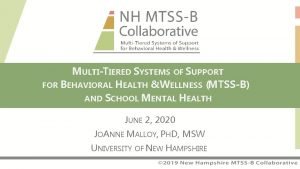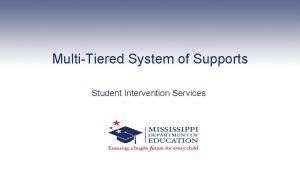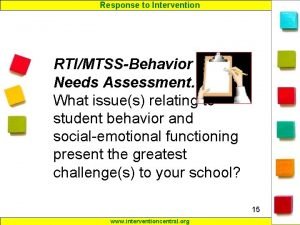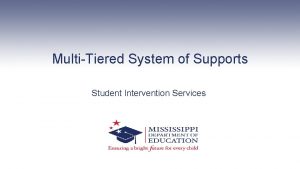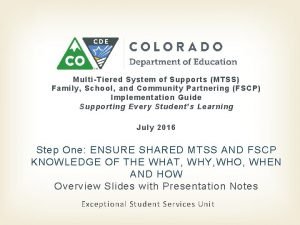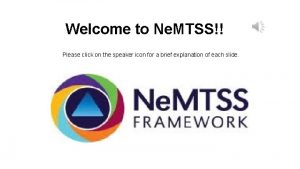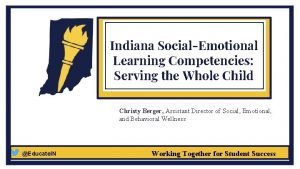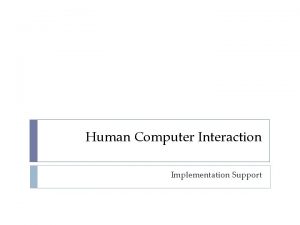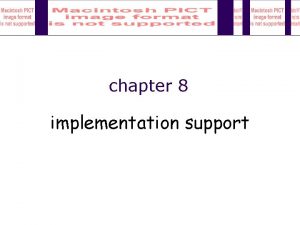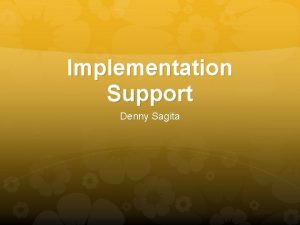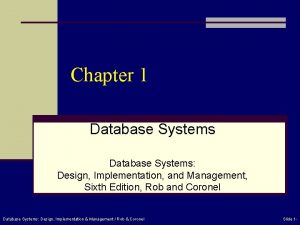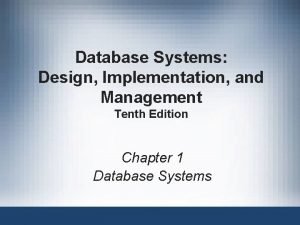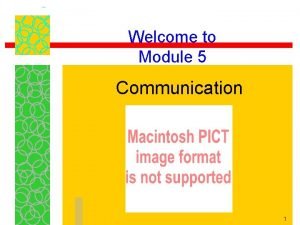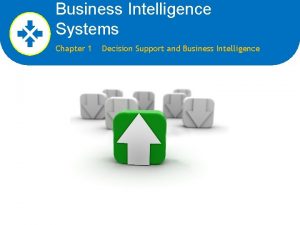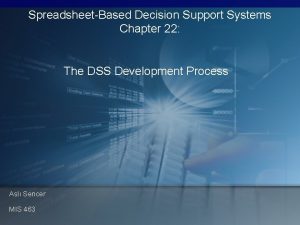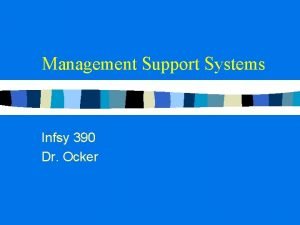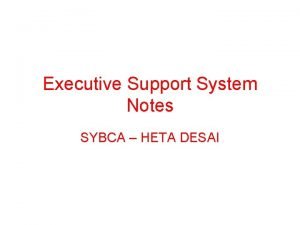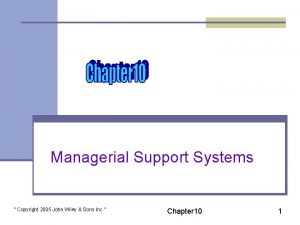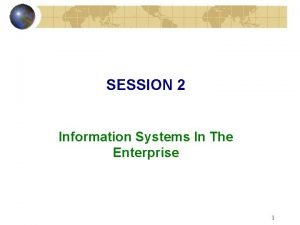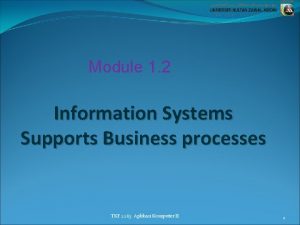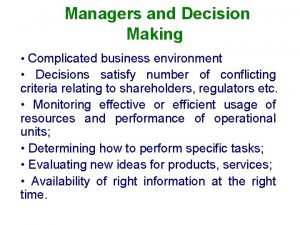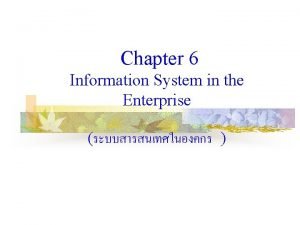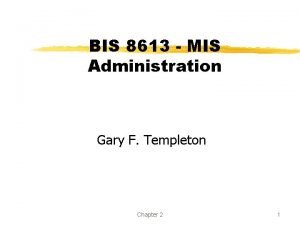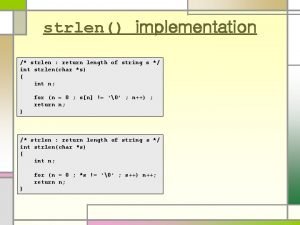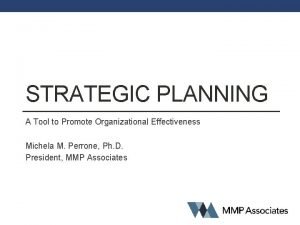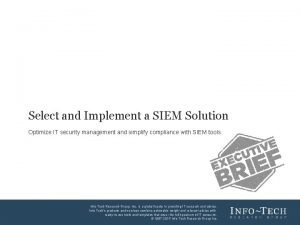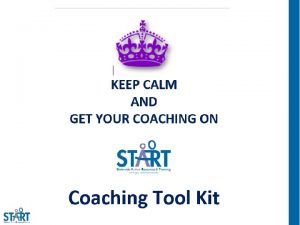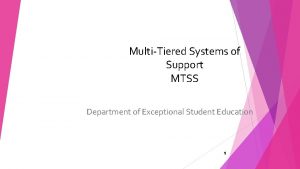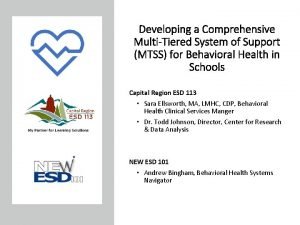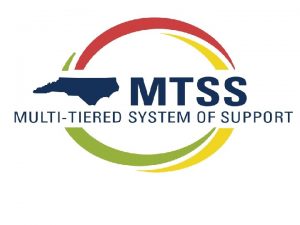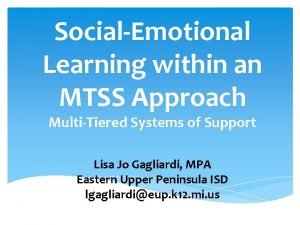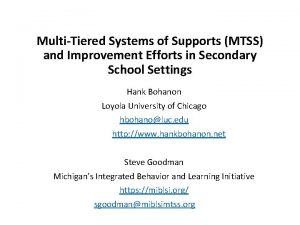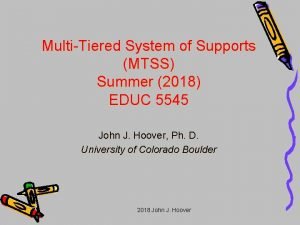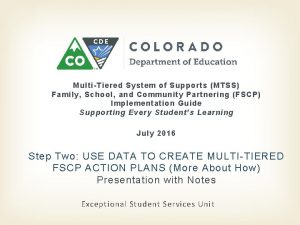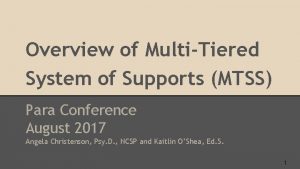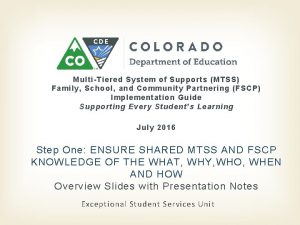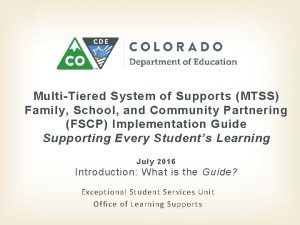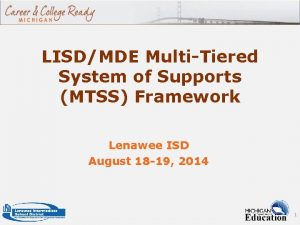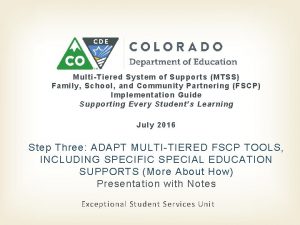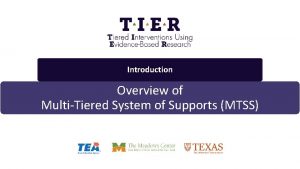Implementation of Multitiered Systems of Support MTSS Module



















































- Slides: 51

Implementation of Multi-tiered Systems of Support (MTSS) Module 1

Welcome! Introductions Materials Parking lot 2

Introductory MTSS Module Series Overview Implementation of Multi-Tiered Systems of Support MTSS Essential Component: Universal Screening MTSS Essential Component: Data-Based Decision Making MTSS Essential Component: High-quality Tier I MTSS Essential Component: Progress Monitoring MTSS Essential Component: Evidence-based Tier II MTSS Essential Component: Data-based Individualization for Tier III 3

Session Outcomes By the end of this session, participants will be able to: • Identify two benefits of schoolwide MTSS implementation • Identify the four essential components of MTSS implementation • Explain how MTSS aligns with and supports existing state and district initiatives • Establish an MTSS team to support schoolwide implementation 4

Activator Activity Handout 1. 1 5

6

Why MTSS? 7

Why MTSS? Sustained improvements in academic performance for ALL students Decreased expulsion, behavioral referrals, and suspension rates (Source: Burns, Appleton, & Stehouwer, 2005; Dexter, Hughes, & Farmer, 2008; Simmons, Coyne, Kwok, Mc. Donagh, Harn, & Kame’enui, 2008) 8

Why MTSS? Strong positive effects on system outcomes • Decreased inappropriate special education referral and placement rates • Reduction in student time in special education services • Reduction in student grade retention (Source: Burns, Appleton, & Stehouwer, 2005; Dexter, Hughes, & Farmer, 2008; Simmons, Coyne, Kwok, Mc. Donagh, Harn, & Kame’enui, 2008) 9

Outcomes of Effective MTSS Implementation Opportunities for early intervention Enhanced collaboration Reduction in behavior referrals Positive impact on student learning and achievement 10

Video: MTSS Coach Handout 1. 1 11

What Is MTSS in Wyoming? 12

13

Defining MTSS integrates assessment and intervention within a schoolwide, multilevel prevention system to maximize student achievement and reduce behavior problems. (Adapted from National Center on Response to Intervention, 2010) 14

MTSS Vision and Hearing Behavior (PBIS) Health (e. g. , Weight, Height, Scoliosis) Social-Emotional Academics Speech and Language 15

Understanding MTSS With an MTSS prevention framework, schools • Identify students at risk for poor learning outcomes • Monitor student progress • Provide evidence-based interventions • Adjust the intensity and nature of those interventions on the basis of a student’s responsiveness • May use it as part of the determination process for identifying students with specific learning disabilities (Source: National Center on Response to Intervention, 2010) 16

Essential Components of Wyoming MTSS 17

Multilevel Prevention System Students With Disabilities Receive services at all levels, depending on need 15% of students Tier 1: Universal Level of Prevention 3% to 5% of students Tier 3: Intensive Level of Prevention Tier 2: Targeted Level of Prevention 80% of students 18

Intervention Levels and Tiers Tier III Instruction or Intervention Approach Comprehensive, research-based curriculum Standardized, targeted small-group instruction Individualized, based on student data Group Size Classwide (with some 3– 7 students small-group instruction) No more than 3 students Assessment Screening, 3 times yearly At least biweekly or monthly Weekly Population Served All students Students identified as at risk (~15%– 20%) Significant and persistent learning needs, nonresponders (3%– 5%) 19

Screening Purpose Identify students who are at risk for poor learning outcomes Focus ALL students Tools Brief assessments that are valid and reliable and that demonstrate diagnostic accuracy for predicting learning or behavioral problems Time Frame Administered more than one time per year (e. g. , fall, More to winter, spring) come in Module 2! 20

Progress Monitoring Purpose Monitor students’ response to primary, secondary, or tertiary instruction in order to estimate rates of improvement, identify students who are not demonstrating adequate progress, and compare the efficacy of different forms of instruction Focus Students identified through screening as at risk for poor learning outcomes Tools Brief assessments that are valid, reliable, and evidence-based More to Time Frame Students are assessed at regular intervals (e. g. , weekly, biweekly, or monthly) come in Module 5! 21

Data-Based Decision Making ü Analyze data at all levels of MTSS: • Implementation (e. g. , state, district, school, grade level) • Prevention (i. e. , primary, secondary, or tertiary) ü Establish routines and procedures for making decisions ü Set explicit decision rules ü Use data to evaluate effectiveness of: • Core curriculum • Instructional and behavioral strategies More to come in Module 3! 22

Clarifying Misconceptions About MTSS • Which of these misconceptions do you frequently encounter? • What are some questions you have about the misconceptions? • What are some ways you can support staff in recognizing the misconceptions and improving implementation of an MTSS framework? Handout 1. 2 23

Wyoming MTSS Fidelity Rubric Handout 1. 3 24

Optional Team Activity: MTSS Fidelity of Implementation Self-Assessment As a team, rate the extent to which your school is implementing each criterion for the four essential components. Handout 1. 4 25

Reflection: MTSS Fidelity Rubric Individually or with your team group, reflect on the following questions: • What MTSS components are implemented fully at your site? • What MTSS components are implemented partially at your site? • What MTSS components are currently absent from implementation at your site? 26

Aligning MTSS With Existing Activities 27

Making Connections What connections to you see among the essential components of MTSS and existing initiatives in your school and district? Handout 1. 5 28

Federal Initiative Alignment With MTSS: Every Student Succeeds Act (ESSA) • Evidence-based practices have an increasingly prominent role in federal policy. • ESSA requires use of evidence-based interventions. 29

Addressing Needs of All Students Comparison of Disaggregated PAWS 3 rd Performance, 2013 -14 to 2015 -16 SY 100 90 80 70 60 50 40 30 20 10 0 2013 -14 2014 -15 2015 -16 English Language Learners Individual Education Plan (IEP) Free/Reduced Lunch All Students Source: PAWS and WY-Alt Results Disaggregated – State Level, http: //fusion. edu. wyoming. gov/My. Sites/Data_Reporting/data_reporting_assessment_reports. aspx 30

Wyoming State Initiatives Increasing third-grade reading proficiency • Goal: Increase to 65% of third-grade students scoring proficient or better by the end of the 2019– 20 school year 31

Wyoming State Initiatives State Systemic Improvement Plan (SSIP) • Comprehensive, ambitious, yet achievable • Multiyear • Designed to improve outcomes for children with disabilities • Uses MTSS and data-based individualization at Tier III For more information, visit http: //wyominginstructionalnetwork. com/spdginitiatives/ssip/ 32

MTSS Team 33

Use structures and clear processes to guide decision making Meet regularly on a predetermined schedule Represent all key stakeholders Effective MTSS Teams 34

Successful MTSS Teams Focus on… • Student outcomes • Alterable variables • Results not process • Smallest change that can create the biggest effect • Prevention • Evidence-based interventions 35

Successful MTSS Teams… • Recognize adult behavior must change to support student learning and behavior effectively • Use problem solving at all levels and across academic and social behavior for students and adults • Recognize it is an ongoing process • Celebrate! What is the problem? Did it work? DATA Why is this happening? What should be done? Handout 1. 6 36

Representation of Key Stakeholders • Team Member Representation – – Administrators Classroom teachers (i. e. , special and general education representation) Specialists (e. g. , coaches, interventionists, English language learners) Family representation • Team Knowledge and Expertise – – Data analysis and interpretation Content knowledge (e. g. , behavior, math, reading) Authority to allocate resources Knowledge of family and community needs 37

MTSS Teams at Each Level Must Have … ü Clear purpose ü Problem-solving process ü Roles, responsibilities, and norms ü Decision-making rules ü Communication system ü Meeting schedule ü Data sources that drive their decisions 38

Purposes of School MTSS Team • Promote common understanding and vision of MTSS and communicate how MTSS components interface with current initiatives • Consider cultural and contextual needs of school population • Lead implementation of essential components • Establish a list of resources available to school and staff, including developing a menu of available interventions 39

Purposes of School MTSS Team • Evaluating the MTSS process at the school level • Plan MTSS professional development efforts relative to needs of staff • Determine protocol for MTSS data warehousing • Establish lines of communication • Analyze and interpret MTSS data 40

Video: Wyoming MTSS Team Examples 41

Handout 1. 7: MTSS Teaming Structures Task 1: Identify team members Task 2: Develop team norms and roles Task 3: Establish MTSS team schedule Task 4: Create a meeting agenda Handout 1. 7 42

Closing and Next Steps 43

Revisit and Think-Pair-Share Handout 1. 1 44

Handout 1. 8: Resources to Support MTSS Implementation • Documents • Videos • Webinars • Tools • Training modules • General web resources 45

Resources: Wyoming MTSS Implementation Supports http: //wyominginstructionalnetwork. com/spdginitiatives/mtss/ 46

Resources: Web Resources Center on Response to Intervention www. rti 4 success. org RTI Action Network www. rtinetwork. org National Center on Intensive Intervention www. intensiveintervention. org 47

Next Steps Complete the Module 1 quiz Establish and convene your district/school team Assess team knowledge of MTSS Complete Module 2: Universal Screening 48

For More Information Bart Lyman Wyoming State MTSS Coach blyman@uinta 1. com Jennifer Hiler Wyoming State Personnel Development Grant Program Manager jennifer. hiler@wyo. gov 49

References 50

References Aceves, T. C. , & Orosco, M. J. (2014). Culturally responsive teaching (Document No. IC-2). Gainesville, FL: University of Florida, Collaboration for Effective Educator, Development, Accountability, and Reform Center. Retrieved from http: //ceedar. education. ufl. edu/wpcontent/uploads/2014/08/culturally-responsive. pdf Burns, M. K. , Appleton, J. J. , & Stehouwer, J. D. (2005). Meta-analytic review of responsiveness-to-intervention research: Examining field-based and research-implemented models. Journal of Psychoeducational Assessment, 23(4), 381– 394. National Center on Response to Intervention. The essential components of RTI. Retrieved from www. rti 4 success. org Dexter, D. D. , Hughes, C. A. , & Farmer, T. W. (2008). Responsiveness to intervention: A review of field studies and implications for rural special education. Rural Special Education Quarterly, 27(4), 3– 9. Simmons, D. C. , Coyne, M. D. , Kwok, O. M. , Mc. Donagh, S. , Harn, B. A. , & Kame'enui, E. J. (2008). Indexing response to intervention: A longitudinal study of reading risk from kindergarten through third grade. Journal of Learning Disabilities, 41(2), 158– 173. 51
 Decision support systems and intelligent systems
Decision support systems and intelligent systems Mtss and udl
Mtss and udl Mtss memes
Mtss memes Mtss-b
Mtss-b Mde mtss documentation packet
Mde mtss documentation packet Mtss needs assessment
Mtss needs assessment Mtss documentation packet
Mtss documentation packet Benefits of mtss
Benefits of mtss Mtss
Mtss Mtss nebraska
Mtss nebraska Trazabilidad mtss
Trazabilidad mtss Mtss infographic
Mtss infographic Indiana department of education social emotional learning
Indiana department of education social emotional learning What is user support in hci
What is user support in hci Implementation support
Implementation support Implementation support
Implementation support C device module module 1
C device module module 1 Traditional approach of development
Traditional approach of development Database systems: design, implementation, and management
Database systems: design, implementation, and management Database systems design implementation
Database systems design implementation Support module
Support module Support oral module 5
Support oral module 5 Linux security modules
Linux security modules Major details
Major details Module 10 drivers ed virginia
Module 10 drivers ed virginia Module 4 operating systems and file management
Module 4 operating systems and file management Module 10 the nervous and endocrine systems
Module 10 the nervous and endocrine systems Swagelok seal support systems
Swagelok seal support systems Decision support and business intelligence systems
Decision support and business intelligence systems Developing spreadsheet-based decision support systems
Developing spreadsheet-based decision support systems Dr ocker
Dr ocker Executive support system
Executive support system Eolss
Eolss Managerial support systems
Managerial support systems Decision support system in business intelligence
Decision support system in business intelligence Executive support systems
Executive support systems Executive support systems
Executive support systems Executive support systems
Executive support systems World oldest tree using
World oldest tree using Executive support systems
Executive support systems Decision support and expert systems
Decision support and expert systems Executive support systems
Executive support systems Professional support systems
Professional support systems Unit 5 international business p8
Unit 5 international business p8 Engineering elegant systems: theory of systems engineering
Engineering elegant systems: theory of systems engineering Embedded systems vs cyber physical systems
Embedded systems vs cyber physical systems Elegant systems
Elegant systems Strlen c implementation
Strlen c implementation Structure follows strategy
Structure follows strategy Strategy implementation
Strategy implementation Strategic implementation plan
Strategic implementation plan Siem implementation project plan template
Siem implementation project plan template



